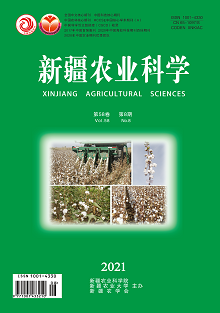|
|
Effects of Recommended Fertilization on Cotton Yield and Fertilizer Efficiency by Nutrient Expert System
SUN Huijian, YAO Qingqing, HE Zhengsheng, WANG Dongli, Halihashi Yibati, ZHANG Yan
2021, 58(8):
1406-1417.
DOI: 10.6048/j.issn.1001-4330.2021.08.005
【Objective】 Aimed at the present situation of more fertilizer consumption and unreasonable application in cotton planting in Xinjiang, a cotton nutrient expert system (Nutrient Expert for Cotton, NE) has been established to study its application effect on cotton. 【Methods】 In 2020, field trials were carried out in Korla and Yuli. A total of 7 experiment fields were set up, and they were all fertilized differently. One field was fertilized by completely following the recommendation of cotton nutrient expert system. Three fields were fertilized the similar way but without nitrogen (NE-N), phosphorus or potassium. Two were fertilized by soil testing formula and farmers' habitual way. The last one was not fertilized at all. 【Results】 The results showed that in the experimental sites in Korla and Yuli, there were barely any crop yield differences between the fields fertilized by following the cotton nutrient expert system and OPTS treatment, and FP methods. NE treatments increased the yield by 4.0% and 4.2% respectively compared with FP treatment, and improved the economic benefit by11.34% and 9.96%. NE treatment promoted the absorption and utilization of nitrogen, phosphorus, and potassium by cotton, and realized the balance of soil nutrients. The partial productivity of NE treated nitrogen, phosphorus and potassium fertilizers in Korla and Yuli were 31.0, 49.0, 67.4 kg/kg and 27.2, 59.0, 59.5 kg/kg, and the partial productivity of nitrogen and phosphorus fertilizers in the two places was significantly higher than that of FP treatment. In Korla, the partial productivity of potassium fertilizer was significantly higher than that of FP treatment, while Yuli was higher than FP treatment, but the difference was not significant; For Korla and Yuli, the agronomic efficiency of nitrogen and phosphate fertilizer NE treatment at these two experimental fields was significantly higher than that of FP treatment. In Korla, NE treatment was significantly higher than that of FP treatment, and the difference between NE treatment and FP treatment in Yuli was not significant. In both Korla and Yuli, the agronomic efficiency of N and P fertilizer under NE treatment was significantly higher than that of FP treatment; there was no significant difference in agronomic efficiency between NE ang FP Treatments. The agronomic efficiency of N, P, K fertilizer in Korla was 6.5, 3.8 and 3.2 kg/kg, respectively,the agronomic efficiency of N, P, K fertilizer in Yuli County were 13.8, 9.9 and 11.2 kg/kg, respectively; the NPK recovery rates in Korla and Yuli after NE treatment were 42.3%, 10.7%, 32.2% and 54.0%, 8.1%, 29.1%, which were significantly higher than that of the FP treatment, 23.7,8.5,19.6 and 28.1, 6.7,7.5 higher, respectively. 【Conclusion】 In summary, the experiments in Korla and Yuli have shown that the cotton nutrient expert system has guided and optimized the application amount and methods of nitrogen, phosphorus, and potassium fertilizers, which not only increased yields, improved economic benefits, and promoted the absorption and utilization rate of nitrogen, phosphorus and potassium nutrients and soil nutrient balance of cotton field. This method is convenient and fast, and can be popularized and applied as a recommended fertilizing method for cotton in Xinjiang.
|

